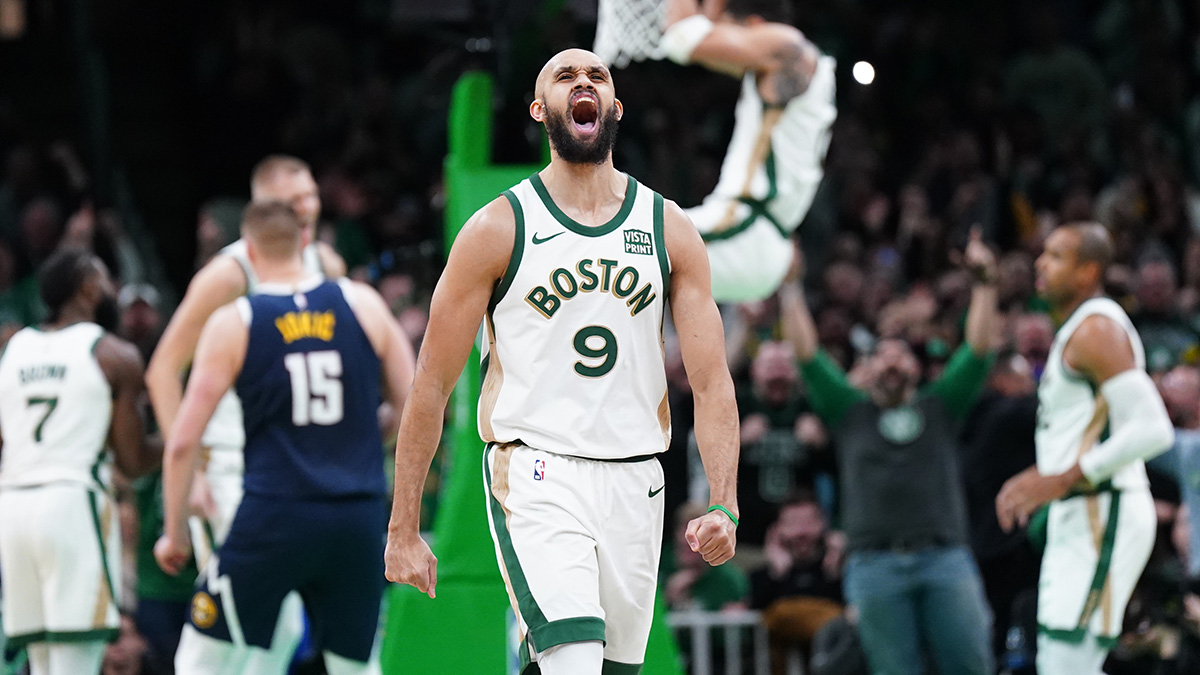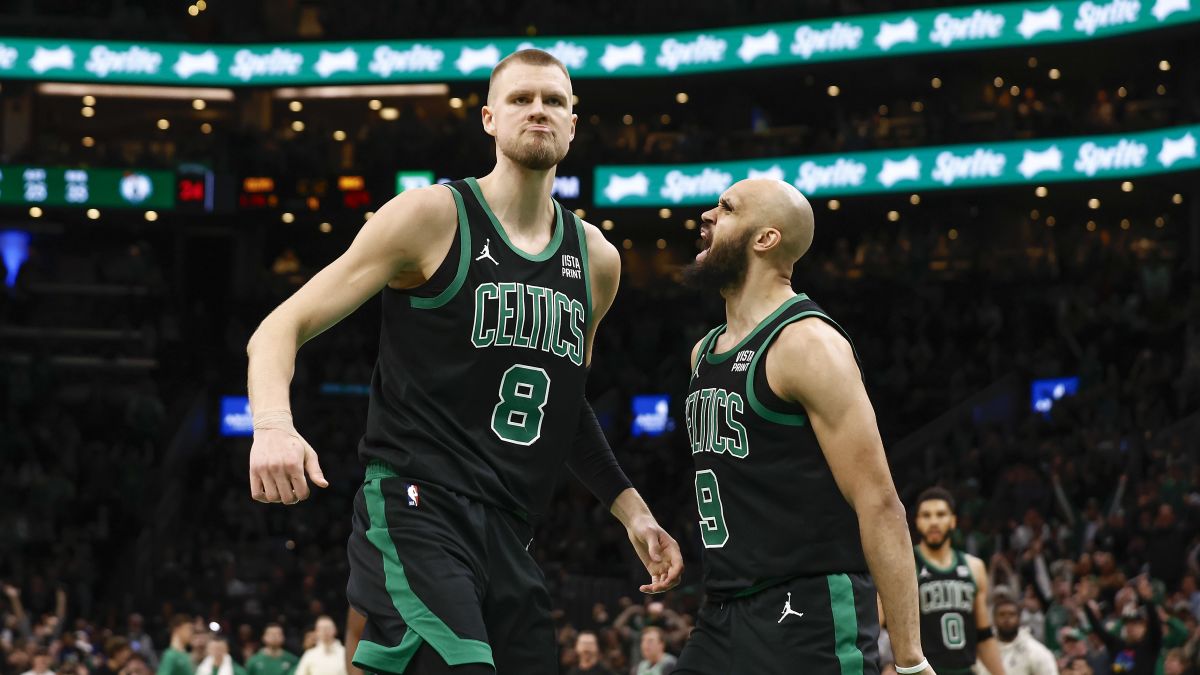The year is 2037 and 39-year-old Jayson Tatum is winding down a Hall of Fame career having successfully hung around long enough to play alongside his son, Deuce. The elder Tatum’s trophy case is overflowing, especially after his run of scoring titles in the late 2020s.
Tatum’s presence has kept the Celtics a title contender for the better part of two full decades. The team only landed Deuce, the No. 1 overall pick in the 2036 draft, because Danny Ainge traded the aging All-Star duo of Jaylen Brown and Robert Williams to the Nets in exchange for three future first-round picks and a couple of pick swaps. Nos. 7 and 44 will soon hang in the rafters.
Stay in the game with the latest updates on your beloved Boston sports teams! Sign up here for our All Access Daily newsletter.
Celtics Talk Podcast: Offseason chaos; exclusive interviews with Danny Ainge and Brad Stevens | Listen & subscribe | Watch on YouTube
For all the success that the Celtics have enjoyed during Tatum's career, there is one season that sticks out like a sore thumb: The 2020-21 campaign. And whenever sportswriters pore over his lofty career accomplishments, they are perplexed by the outlier -- in terms of Boston’s success, not Tatum’s production -- in his age 22 season.
A 36-36 record? The seventh seed in the East? A spot in the inaugural play-in tournament? Getting unceremoniously dispatched in the opening round of the playoffs by old friend Kyrie Irving and the Nets?
Boston Celtics
Those of us that were around will shake our heads and try to explain this bizarre season. We’ll note the quick turnaround from the 2020 Bubble, how COVID ravaged Boston’s roster, and all the injury woes the team endured as well. We’ll shrug when asked how it could have been that bad with Tatum and Brown at the infancy of their All-Star runs. We’ll chuckle recalling the rumors about coach Brad Stevens, who, now at age 60, still hasn't taken the Indiana University job.
OK, back to present day.
Boston's 2020-21 season mercifully ended on Tuesday night with a 123-109 loss to the Brooklyn Nets. The Celtics finished the season with three starters -- Brown, Williams, and Kemba Walker -- watching from the sidelines due to injuries. It was a fitting end for a season in which the Celtics did not have their top 7 available for any of the 78 games they played.
Yep, just a strange and infuriating season in which a poorly constructed roster left Boston vulnerable to the oddities of a condensed schedule.
That brief glimpse into the future above hinges heavy on what comes next and Ainge, under the microscope given Boston’s imperfect roster, has a hefty summer to-do list with the goal of righting some wrongs and re-positioning this team as a surefire contender.
The Celtics are still well positioned with Tatum and Brown -- and Stevens, too, though he’s got to prove he can get the most out of this core. But there is undeniably a lot of work ahead to shape a contender around the Jays.
Here are five big questions the Celtics must answer this summer:
Is Kemba Walker back next season?
Walker, plagued by knee woes since January 2020, missed the final two games of the playoffs with what the team termed a medial bone bruise on the balky left knee the team spent so much time managing with hopes of having him healthy during the postseason.
The 31-year-old Walker has two seasons and $73.7 million remaining on the maximum-salary contract he signed with Boston in 2019 (the final year is a player option). He’s been a fantastic teammate and expedited the development of the Jays, but there are concerns about both his health woes and his long-term fit alongside Tatum and Brown.
The question is do the Celtics cross their fingers and hope a more normally paced season allows Walker to stay upright and be a more consistent presence? Or do they explore potentially cumbersome trade options given his bulky salary that could require Boston to send out prime draft assets, or take on a more onerous contract, in order to facilitate a deal.
Walker might just be the biggest domino to fall. If the Celtics elect to stick it out with him, then there’s tougher decisions about resources given a ballooning cap sheet. If Walker remains in green then it means others like Marcus Smart may not.
Do the Celtics re-sign Evan Fournier?
The Celtics used part of the Gordon Hayward trade exception to land Fournier at the trade deadline with hopes of beefing up their depth and fortifying their playoff rotation. Fournier got limited regular-season reps, though, after a battle with COVID and then was up and down in the playoffs where he was a more featured presence with Brown sidelined by wrist surgery.
The Celtics must decide if they will pay Fournier market price, which could be hefty given his offensive talents. The 28-year-old gave Boston needed size and shooting but his defensive deficiencies could limit just how much the Celtics are willing to splurge to keep him around.
Regardless, Boston has to maximize their asset, especially after using the majority of the Hayward TPE to land him. There could be sign-and-trade avenues if Fournier is not back. Alas, that might simply generate another hefty trade exception and start the cycle of speculation about how Boston might use it all over again.
Is Marcus Smart still part of this core long term?
Smart is set to enter the final year of his deal where he will earn a modest $14.3 million. But the Celtics must decide sooner than later if they’re going to pay Smart his next contract.
That decision might hinge on what happens with Walker. If the Celtics move on from Walker, then paying Smart to be your starting point guard is an easier decision.
Smart’s playmaking is criminally underrated and, when he puts an emphasis on creating for others and limits his 3-point shots, he’s a valuable player. At times his defense waned during the 2020-21 season but he remains the pulse of the team. It’s hard to envision a Stevens squad without Smart but it’s something the team has to consider while thin on trade assets. Smart is exactly the sort of gritty veteran that contenders salivate for.
What happens at the center position? Do the Celtics extend Robert Williams?
The Celtics made Tristan Thompson their big free-agent addition last summer and then banked on the health of Robert Williams while dealing Daniel Theis at the trade deadline to stay beneath the tax. Neither move played out quite like the team hoped.
Thompson is under contract for $9.7 million next season but could be trade fodder if the team yearns for more of a floor-spreader to tag-team with Williams up front. For all his talents on the glass, the offense often bogged down with Thompson.
Williams is extension eligible. The injury issues make that an obvious gamble for both sides but the talent is undeniable. The two sides could potentially find a sweet spot that gives Williams some long-term security and locks in a potential key piece at a prime position at manageable money.
Luke Kornet is a free agent but could potentially be retained at low money as a third big. An interesting decision looms with fan favorite Tacko Fall after two seasons as a two-way player.
Who sticks at the back end of the roster?
There is reason to be optimistic with the 2020 draft class. Payton Pritchard was a steady rotation presence this season and Aaron Nesmith came on strong. Barring a need for trade assets in a bigger deal, that duo should be back next season. Getting young, cost-controlled talent that can supplement the core is imperative for a Boston team that’s paying big money for its stars.
Things are a bit murkier with the 2019 draft class. Romeo Langford has been an excellent defender but must develop a consistent 3-point shot to truly be a consistent rotation presence. He got valuable experience this postseason.
Grant Williams has had some fantastic stretches as small-ball center but struggled at the 4. Carsen Edwards and Tremont Waters have obvious potential but haven’t been consistent enough to get the sort of time that they need to develop.
The bottom line is that Boston’s bench just wasn’t good enough this season and the Celtics were left perilously thin whenever injuries or illness occurred -- which was essentially every single game. Ainge has to reconstruct the back end of this roster and that’s going to mean swallowing hard on players that he’s been hoping might pan out.
Jabari Parker, picked up off the scrapheap late in the year, could be a nice find if Boston can tap into his potential with more time in the system.
Boston needs to find the starter-caliber 4 that they missed on last offseason. That could allow the team to slide Tatum and Brown into the 2-3 roles and give the team flexibility on how it rolls out lineups.
Hanging onto someone like Semi Ojeleye has been a luxury in recent years but it’s time to find veterans that Stevens can more confidently trust in bigger roles, particularly when the injury bug invariably nibbles on this squad.
The Celtics also need to identify two-way players that can both be an attraction for the rebranded Maine Celtics but also be leaned on by the NBA squad in a pinch.
There’s a lot of heavy lifting ahead. The bones of this project are solid but there’s some serious reconstruction needed, especially as the Eastern Conference neighbors have all poured resources into making their properties more attractive.


